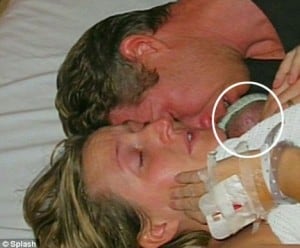
By: Amanda Froelich,
It’s the news every parent dreads “I’m sorry, but your child did not make it”. After carrying twins Jamie and Emily for 27 weeks, mother Kate Ogg prematurely gave birth in the Sydney, Australian hospital unit. While twin, Emily, was brought into the world healthfully, it was 2 lb Jamie that was pronounced dead after a brutal 20 minutes attempting to resuscitate him.
Heartbroken at the news of their son, Kate and husband David Ogg clasped each other and their son for the final chance to say good bye. Having given up on a miracle, Kate unwrapped the baby from his blanket and held him against her skin; it was then an extraordinary thing happened.
Almost two hours after being pronounced dead, little Jamie began showing signs of life after being hugged, touched, and spoken to by his mother. At first it was just a gasp of air dismissed by doctors as a reflex, but when she started feeding him breast milk on her finger, he started to breath normally.
In shock, Ogg recounts ‘I thought ‘Oh my God, what’s going on.’
‘A short time later he opened his eyes. It was a miracle. Then he held out his hand and grabbed onto my finger.’
Doctors who had given up hope also shared their incredulous disbelief at his re-entrance into life.
Five months after the joyful event in the Sydney hospital, Kate Ogg opened up about the importance of skin-to-skin contact, and how by following her intuition, her son was saved.
An increasing rate of Britain hospitals are initiating skin-to-skin contact, or the ‘kangaroo technique’ with incredible success. The method is named after the way kangaroos hold their young in a pouch next to their bodies, acting as an incubator to keep the baby warm, stimulated, and fed. Research has shown that the adoption of this technique for pre-term and low-birth infants causes lower infection rates, less severe illnesses, improved sleep patterns, and a reduced risk for hypothermia.
Natural birthing techniques maintain that nature calls for a mother to be closely connected to their child right after birth as it increases Oxytocin production, the bonding hormone, and the stimulation of close contact shows to have other benefits as well.
It was after the three-hour labor, told that Jamie was gone, that Kate followed the need to coddle her son. Respecting her nurturing intuition, it’s motherly instinct that saved Jamie’s life and may hopefully serve as an example of the extraordinary power of human love for the future.
Sources:


